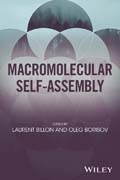
This book describes techniques of synthesis and self–assembly of macromolecules for developing new materials and improving functionality of existing ones. Because self–assembly emulates how nature creates complex systems, they likely have the best chance at succeeding in real–world biomedical applications. Employs synthetic chemistry, physical chemistry, and materials science principles and techniques Emphasizes self–assembly in solutions (particularly, aqueous solutions) and at solid–liquid interfaces Describes polymer assembly driven by multitude interactions, including solvophobic, electrostatic, and obligatory co–assembly Illustrates assembly of bio–hybrid macromolecules and applications in biomedical engineering INDICE: List of Contributors ix .Preface xiii .1 A Supramolecular Approach to Macromolecular Self–Assembly: Cyclodextrin Host/Guest Complexes 1Bernhard V. K. J. Schmidt and Christopher Barner–Kowollik .1.1 Introduction, 1 .1.2 Synthetic Approaches to Host/Guest Functionalized Building Blocks, 3 .1.2.1 CD Functionalization, 3 .1.2.2 Suitable Guest Groups, 5 .1.3 Supramolecular CD Self–Assemblies, 7 .1.3.1 Linear Polymers, 7 .1.3.2 Branched Polymers, 12 .1.3.3 Cyclic Polymer Architectures, 17 .1.4 Higher Order Assemblies of CD–Based Polymer Architectures Toward Nanostructures, 17 .1.4.1 Micelles/Core–Shell Particles, 17 .1.4.2 Vesicles, 19 .1.4.3 Nanotubes and Fibers, 20 .1.4.4 Nanoparticles and Hybrid Materials, 21 .1.4.5 Planar Surface Modification, 22 .1.5 Applications, 23 .1.6 Conclusion and Outlook, 26 .References, 26 .2 Polymerization–Induced Self–Assembly: The Contribution of Controlled Radical Polymerization to The Formation of Self–Stabilized Polymer Particles of Various Morphologies 33Muriel Lansalot, Jutta Rieger, and Franck D Agosto .2.1 Introduction, 33 .2.2 Preliminary Comments Underlying Controlled Radical Polymerization, 36 .2.2.1 Introduction, 36 .2.2.2 Major Methods Based on a Reversible Termination Mechanism, 37 .2.2.3 Major Methods Based on a Reversible Transfer Mechanism, 39 .2.3 Pisa Via CRP Based on Reversible Termination, 40 .2.3.1 PISA Using NMP, 40 .2.3.2 Using ATRP, 46 .2.4 Pisa Via CRP Based on Reversible Transfer, 48 .2.4.1 Using RAFT in Emulsion Polymerization, 48 .2.4.2 Using RAFT in Dispersion Polymerization, 61 .2.4.3 Using TERP, 70 .2.5 Concluding Remarks, 71 .Acknowledgments, 73 .Abbreviations, 73 .References, 75 .3 Amphiphilic Gradient Copolymers: Synthesis and Self–Assembly in Aqueous Solution 83Elise Deniau–Lejeune, Olga Borisova, Petr t¡epánek, Laurent Billon, and Oleg Borisov .3.1 Introduction, 83 .3.2 Synthetic Strategies for The Preparation of Gradient Copolymers, 86 .3.2.1 Preparation of Gradient Copolymers by Controlled Radical Copolymerization, 87 .3.2.2 Preparation of Block–Gradient Copolymers Using Controlled Radical Polymerization, 106 .3.3 Self–Assembly, 110 .3.3.1 Gradient Copolymers, 110 .3.3.2 Diblock–Gradient Copolymers, 111 .3.3.3 Triblock–Gradient Copolymers, 113 .3.4 Conclusion and Outlook, 114 .Abbreviations, 115 .References, 117 .4 Electrostatically Assembled Complex Macromolecular Architectures Based on Star–Like Polyionic Species 125Dmitry V. Pergushov and Felix A. Plamper .4.1 Introduction, 125 .4.2 Core–Corona Co–Assemblies of Homopolyelectrolyte Stars Complexed with Linear Polyions, 127 .4.3 Core–Shell–Corona Co–Assemblies of Star–Like Micelles of Ionic Amphiphilic Diblock Copolymers Complexed with Linear Polyions, 130 .4.4 Vesicular Co–Assemblies of Bis–Hydrophilic Miktoarm Stars Complexed with Linear Polyions, 133 .4.5 Conclusions, 137 .Acknowledgment, 137 .References, 137 .5 Solution Properties of Associating Polymers 141Olga Philippova .5.1 Introduction, 141 .5.2 Structures of Associating Polyelectrolytes, 142 .5.3 Associating Polyelectrolytes in Dilute Solutions, 142 .5.3.1 Intramolecular Association, 145 .5.3.2 Intermolecular Association, 147 .5.4 Associating Polyelectrolytes in Semidilute Solutions, 151 .5.5 Conclusions, 155 .References, 155 .6 Macromolecular Decoration of Nanoparticles for Guiding Self–Assembly in 2D and 3D 159Christian Kuttner, Munish Chanana, Matthias Karg, and Andreas Fery .6.1 Introduction, 159 .6.2 Guiding Assembly by Decoration with Artificial Macromolecules, 160 .6.2.1 Decoration of Nanoparticles, 161 .6.2.2 Distance Control in 2D and 3D, 166 .6.2.3 Breaking the Symmetry, 171 .6.3 Guiding Assembly by Decoration with Biomacromolecules, 173 .6.3.1 DNA–Assisted Assembly, 173 .6.3.2 Protein–Assisted Assembly, 177 .6.4 Application of Assemblies, 181 .6.5 Conclusions and Outlook, 183 .References, 184 .7 Self–Assembly of Biohybrid Polymers 193Dawid Kedracki, Jancy Nixon Abraham, Enora Prado, and Corinne Nardin .7.1 Introduction, 193 .7.1.1 Amphiphiles, 194 .7.1.2 Packing Parameter and Interfacial Tension, 195 .7.1.3 Interaction Forces in Self–Assembly, 196 .7.2 Self–Assembly of Biohybrid Polymers, 198 .7.2.1 Polymer–DNA Hybrids, 198 .7.2.2 Polypeptide Block Copolymers, 204 .7.2.3 Block Copolypeptides, 205 .7.3 Self–Assembly Driven Nucleation Polymerization, 207 .7.3.1 Polymer–DNA Hybrids, 209 .7.3.2 Polymer–Peptide Hybrids, 209 .7.3.3 DNA–Peptide Hybrids, 212 .7.4 Self–Assembly Driven by Electrostatic Interactions, 213 .7.4.1 DNA/Polymer Bio–IPECs, 216 .7.4.2 DNA/Copolymer Bio–IPECs, 216 .7.5 Conclusion, 218 .References, 219 .8 Biomedical Application of Block Copolymers 231Martin Hrubý, Sergey K. Filippov, and Petr t¡epánek .8.1 Introduction, 231 .8.2 Diblock and Triblock Copolymers, 234 .8.3 Graft and Statistical Copolymers, 240 .8.4 Concluding Remarks, 245 .Acknowledgment, 245 .References, 245 .Index 251
- ISBN: 978-1-118-88712-7
- Editorial: Wiley–Blackwell
- Encuadernacion: Cartoné
- Páginas: 272
- Fecha Publicación: 31/10/2016
- Nº Volúmenes: 1
- Idioma: Inglés
